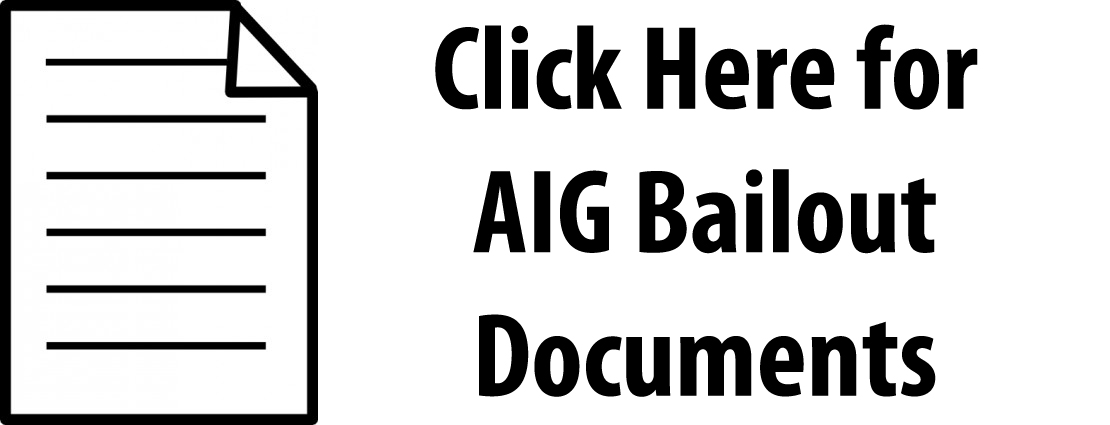New York Federal Reserve Bank/AIG Bailout Documents
Public Access to the New York Fed’s Document Production
In the interests of providing transparency to the American people on how their tax money was spent to prop up failing financial companies and enforcing accountability on the federal agencies that engineered the bailout, Ranking Member Issa is providing the public with access to the documents produced to the Committee on Oversight and Government Reform by the Federal Reserve Bank of New York.
Background
In 2009, the Committee on Oversight and Government Reform began to investigate the bailout of AIG by the Federal Reserve Bank of New York (“New York Fed”). In October, Ranking Member Darrell Issa asked AIG to provide documentation to the Committee to assist its investigation, and AIG voluntarily produced over three thousand pages of documents. AIG’s documents showed that the New York Fed had actively tried to prevent AIG from publicly revealing important details about how its credit-default swap counterparties had benefited from taxpayer-funded payments. Meanwhile, the New York Fed refused to voluntarily provide documents, so Ranking Member Issa urged Chairman Edolphus Towns to issue a legally-binding subpoena. On January 12, 2010, Chairman Towns issued a subpoena requiring the New York Fed to produce all documents relating to payments to AIG’s counterparties, the decision to compensate the counterparties at the par value of their assets, and the public disclosure of those payments.
The New York Fed started to comply with the subpoena on January 19, 2010, when it produced approximately 250,000 pages of documents, including e-mails, Microsoft Word files, and scanned hard copy documents. The New York Fed’s original production was limited to documents created between September 2008 and May 2009. Ranking Member Issa is continuing to call for additional documents from the New York Fed, which has not yet fully complied with the subpoena.
In the meantime, Ranking Member Issa is providing public access to the documents that the New York Fed has already produced.
Why the Documents are Being Made Public
AIG’s counterparties received a far better deal from the New York Fed – funded by taxpayers’ money – than they would have received if AIG had gone through an orderly bankruptcy. To conceal this fact, New York Fed officials managed all of AIG’s public statements and SEC filings and intentionally sought to prevent the public from discovering the truth about the bailout. The documents produced by the New York Fed tell the story of an insider-friendly transaction planned and executed in secret – and the New York Fed hoped to keep it that way. The Committee’s Republican staff produced a report that describes some of the more important documents in the production and explains what they reveal about the bailout. The report is available here.
The documents are being made public for two reasons. First, taxpayers have a right to know how and why billions of dollars of their money was spent, but the New York Fed and the Department of the Treasury have provided inconsistent, incomplete, and ever-changing explanations. The source documents are being made public with the hope that watchdog groups, reporters, financial historians, and the public will scrutinize them and reach their own, independent conclusions. Second, the New York Fed produced hundreds of thousands of pages of e-mails, memoranda, and workpapers – a volume too large to be quickly digested by the Committee’s staff alone. Making the documents public ensures that they will be reviewed by as many critical eyes as possible.
In order to avoid unnecessarily disclosing telephone numbers, non-federal e-mail addresses, and other personally-identifiable information, the Committee staff made a reasonable effort to redact such information from the documents produced by the New York Fed.
How the Documents are Organized
The documents that were produced by the New York Fed to the Committee are divided into two folders: e-mails and electronic files, produced as searchable PDF files; and scanned hard copy documents, produced as non-searchable PDF files. Within each folder, the PDFs are contained in compressed .zip files labeled with the names of the New York Fed staff members in whose files and electronic archives they were found. The .zip files may be opened using freely-available decompression software, such as Winzip, Unzip, or StuffIt. The New York Fed separately produced documents to the Special Inspector General for the Troubled Asset Relief Program (“SIGTARP”). Those documents – also compressed – are contained in a third folder.
